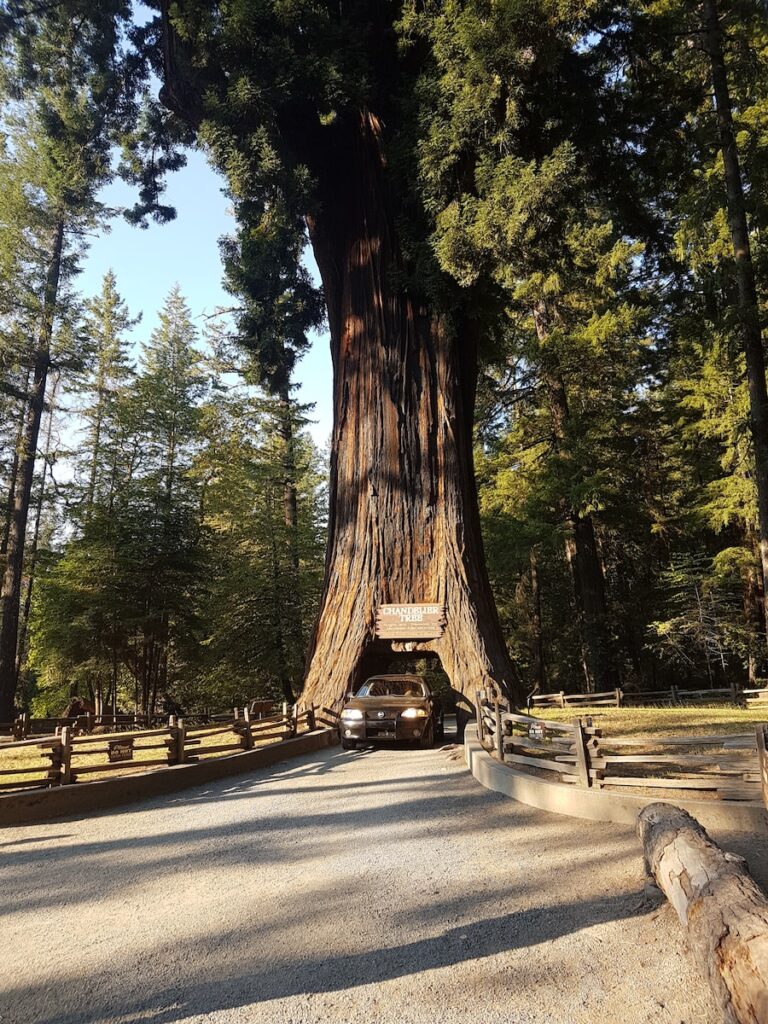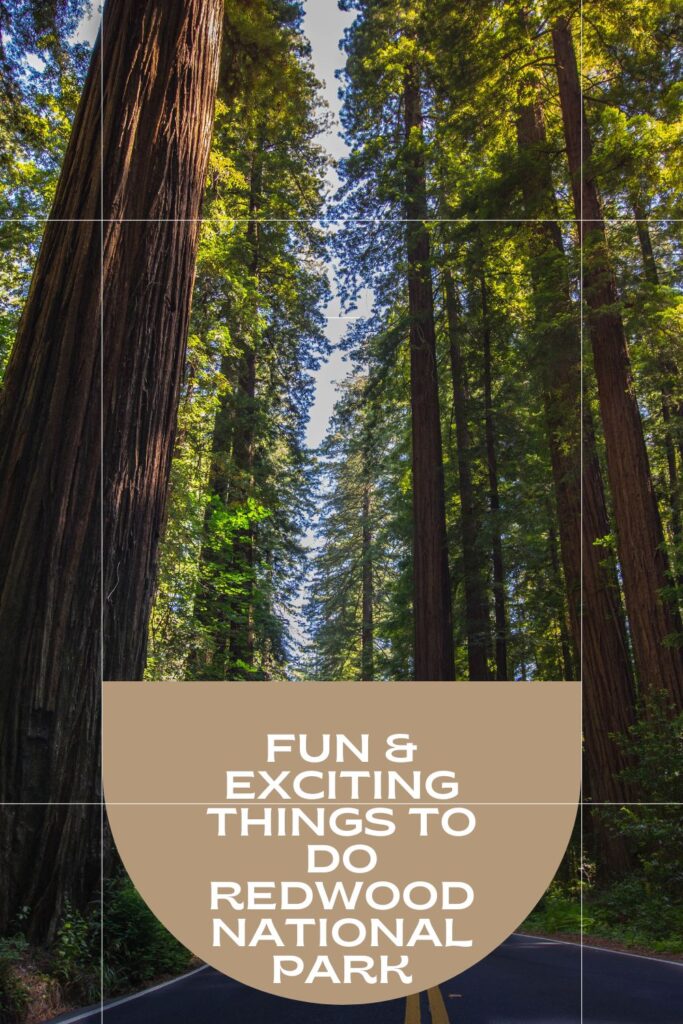
Fun and Exciting Things to Do Redwood National Park
We may earn money or products from the companies mentioned in this post.
The Giant Sequoia’s coastal cousins – the Redwoods – take the prize for tallest trees in the world. These dense and lush forests are spread along California’s northern coast in the Redwood National Park and a visit here is like a trip to the Amazon, vibrant and otherworldly.

The required climate and soil type for Coastal Redwoods are about as specific as that required by the Giant Sequoias. Thankfully, the Redwoods’ requirements are more readily met and large groves of them cover the coastal regions from northern California to southern Oregon. Probably the most accessible and best forests are found in the Humboldt Redwoods State Park and the Redwoods National and State Parks.
Drive-Thru Tree Park
If you’re coming from the south, make sure you stop at the “Drive-Thru Tree Park”, especially if you have children. It’s a private park with one main highlight: you can drive your vehicle through a tunnel carved in a living Redwood tree. There’s also a nice pond and a decent souvenir shop here. It’s just about 40 miles south of the Humboldt Redwoods State Park.
The Humboldt Redwoods State Park is easily accessed by driving north in California on Highway 101. You’ll see a scenic by-pass for “Avenue of the Giants” and you should definitely take it. This road winds and turns through some incredibly beautiful primary and secondary Redwood growth. Along the road are souvenir shops, restaurants, and informative trails. Or, if you want, you can just drive through the scenic route and enjoy the immense living trees that tower around you.
Chimney Tree

One great stop at the south end of the “Avenue of the Giants” is the Chimney Tree. This is a Redwood tree that has been hollowed out by fire, yet is still surviving. You can stand in its 16-foot wide base (accessed by a door in the side of the tree) and look straight up through the middle of the tree and see its own leaves and branches above it. Near the end of the scenic route is the “Immortal Tree” which has survived a lightning strike, attempted logging, and a devastating flood.
That’s one thing about Coastal Redwoods; they seem quite a bit tougher than Sequoias. Sequoias definitely live long (3000+ years to the Redwoods’ 2000 years) and survive their share of fires (and even require them), but the things they survive seem to leave much more of a scar than is left on Redwoods. While a Sequoia might have an ugly black scar that’s rotted away half its base and runs up half the length of the tree, a Redwood barely shows any signs of ancient fires. A Redwood tree’s bark seems to remain much more intact and, in my opinion, is more beautiful than the raggedy bark of a Sequoia.
A few hours north of Humboldt Redwoods State Park will bring you to Redwood National and State Parks. They’re basically inter-connecting and although they operate under slightly different regulations, similar experiences can be had at both. There is no entrance fee for visiting either park, making the Redwoods one of the few free National Parks.
Lodging
Unlike other National Parks, the Redwoods don’t have any official hotel-style lodging opportunities. Still, there are plenty of places for tent and RV camping, but to make sure you get a spot close to the best trails, make sure you come early. There are also many picnic areas and since the park runs parallel to the coast, there are many places for fishing and boating.
Redwood Forests
However, the park’s main attraction is its stunning displays of lush Redwood forests. As stated earlier, I personally think Redwoods are much more beautiful than Sequoias. Their bark is usually completely intact; the forests are denser and have thicker and much more varied undergrowth. Redwood trees aren’t much narrower at the base than their Sequoia cousins and since the forests are much denser, you’re constantly encountering some of the largest specimens.
It’s actually a lot like walking through a rainforest – it’s humid, bright green, and crowded with plants. But the Redwood trees make the experience even more incredible. Their immense size and their tumbled ruins dwarf everything else, including you. The lush ferns and massiveness of everything make you feel like you’re embarking on an adventure the size of King Kong’s Skull Island.
Well-Marked Trails
Thankfully, Redwoods National Park isn’t quite as wild as all that. There are plenty of easy-to-travel well-marked trails that take you into the heart of the forest without too many hills to climb or descend. One of the best places to find good trails is along the Newton B. Drury Scenic Parkway in the central portion of the park. Driving through it is much like driving through the Avenue of the Giants, but it’s a completely uninterrupted stretch through the forest. Most of the trails start from parking areas on the side of the road, so you can easily just pick which one looks best to you.

If you’ve got a few days and you’re interested in more than just the forest, the southern entrance to the park takes you through several lagoons, freshwater, and saltwater. Here, a much different and unique ecology is also protected by the park. The informational paths will give you a chance to enjoy the beach and learn about the lagoons.
Redwood National Park Activities
Redwood National Park is on the coast of Northern California and is named for the Coastal Redwood old-growth forest that it was created to protect. Redwoods are the largest known tree species; about half of the remaining old-growth redwoods can be found in the park. Redwood National Park also has about 37 miles of the Pacific Ocean coastline. Visitors will find a wide variety of activities to enjoy within the park’s 133,000 acres, including hiking, backpacking, and horseback riding.
Hiking
Redwood National Park has more than 200 miles of hiking trails. These trails are divided into three regions: Northern, southern and coastal trails. Trail elevations range from approximately sea level for coastal trails to over 3,000 feet in the northern and southern regions. Trail lengths range from about three-tenths of a mile for two nature trails to 32 miles. Some trails are loops and some connection with one another.
Bicycling
Bicycling is allowed in Redwood National Park but is restricted to certain trails to avoid damaging the environment. Bicycling is allowed on six trails, which range from an easy, flat three miles on the Gold Bluffs Beach Coastal Trail to 19 miles, combining the Gold Bluffs Trail to the Ossagon Loop Trail.
Horseback Riding & Horsepacking

Visitors may bring horses and ride them on designated park trails. Horseback riding trails range from five miles to 32 miles of the Forty-Four Creek Loop Trail. Some trails are steep in places; during inclement weather, they may be shortened by the removal of temporary seasonal bridges over creeks and rivers. Two horse trails, Little Bald Hills Trail and Orick Horse Trail, also have horse campsites for visitors who want to do some horse-packing.
Camping
Camping is another activity that visitors to Redwood National Park can enjoy. The park has developed campgrounds and backcountry campsites. There are four developed campgrounds that can accommodate hikers, bicyclers, and RVs, although RV utility hookups are not available in the park. Three of these campgrounds have hot showers and handicapped-accessible restrooms. The Gold Bluffs Beach Campground only has solar showers; its restrooms are not handicapped-accessible. Eight backcountries, and primitive campgrounds are available throughout the park. Camping permits may be required, depending on the campground and how you are traveling within the park.
Sea Kayaking
Sea kayaking is allowed in Redwood National Park’s coastal region. The park has about 37 miles of coastline that can be explored by kayakers as they paddle over the ocean swells and around the sea stacks. Visitors who don’t have their own kayak can rent one from Kayak Zak’s, a National Park Service-endorsed kayak livery.
Redwoods National and State Parks don’t contain any particularly incredible geological features. But the Redwood forests are like nothing else that you can experience, in their grandeur and wildness. An experience here will not disappoint you.
